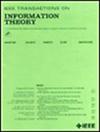基于亚线性稀疏压缩感知的广义近似消息传递
IF 2.9
3区 计算机科学
Q3 COMPUTER SCIENCE, INFORMATION SYSTEMS
引用次数: 0
摘要
本文研究了从广义线性测量中重构具有亚线性稀疏性的未知信号向量。在次线性稀疏性极限下,当N和k趋于无穷时,信号维数N、测量维数M和信号稀疏性k满足$\log k/\log N\to \gamma \in [0, 1$)和$M/\{k\log (N/k)\}\to \delta $,通过状态演化提出广义近似消息传递(GAMP)。虽然状态演化的整体流程与线性稀疏性相同,但内部去噪的每个证明步骤都需要比线性稀疏性更强的假设。证明了贝叶斯内去噪所需要的新假设。在GAMP中使用贝叶斯外消噪器和内消噪器时,利用得到的状态演化递归来评估样本复杂度中的前因子$\delta $,称为重构阈值。当且仅当$\delta $大于重构阈值时,贝叶斯GAMP可以实现渐近精确的信号重构。特别是,当非零信号元素的支持不包括零邻域时,噪声线性测量的重建阈值是有限的。作为数值例子,本文考虑了线性测量和1位压缩感知。两种情况下的数值模拟表明,贝叶斯GAMP在样本复杂度方面优于现有的亚线性稀疏性算法。本文章由计算机程序翻译,如有差异,请以英文原文为准。
Generalized Approximate Message-Passing for Compressed Sensing With Sublinear Sparsity
This paper addresses the reconstruction of an unknown signal vector with sublinear sparsity from generalized linear measurements. Generalized approximate message-passing (GAMP) is proposed via state evolution in the sublinear sparsity limit, where the signal dimension N, measurement dimension M, and signal sparsity k satisfy $\log k/\log N\to \gamma \in [0, 1$ ) and $M/\{k\log (N/k)\}\to \delta $ as N and k tend to infinity. While the overall flow in state evolution is the same as that for linear sparsity, each proof step for inner denoising requires stronger assumptions than those for linear sparsity. The required new assumptions are proved for Bayesian inner denoising. When Bayesian outer and inner denoisers are used in GAMP, the obtained state evolution recursion is utilized to evaluate the prefactor $\delta $ in the sample complexity, called reconstruction threshold. If and only if $\delta $ is larger than the reconstruction threshold, Bayesian GAMP can achieve asymptotically exact signal reconstruction. In particular, the reconstruction threshold is finite for noisy linear measurements when the support of non-zero signal elements does not include a neighborhood of zero. As numerical examples, this paper considers linear measurements and 1-bit compressed sensing. Numerical simulations for both cases show that Bayesian GAMP outperforms existing algorithms for sublinear sparsity in terms of the sample complexity.
求助全文
通过发布文献求助,成功后即可免费获取论文全文。
去求助
来源期刊

IEEE Transactions on Information Theory
工程技术-工程:电子与电气
CiteScore
5.70
自引率
20.00%
发文量
514
审稿时长
12 months
期刊介绍:
The IEEE Transactions on Information Theory is a journal that publishes theoretical and experimental papers concerned with the transmission, processing, and utilization of information. The boundaries of acceptable subject matter are intentionally not sharply delimited. Rather, it is hoped that as the focus of research activity changes, a flexible policy will permit this Transactions to follow suit. Current appropriate topics are best reflected by recent Tables of Contents; they are summarized in the titles of editorial areas that appear on the inside front cover.
 求助内容:
求助内容: 应助结果提醒方式:
应助结果提醒方式:


